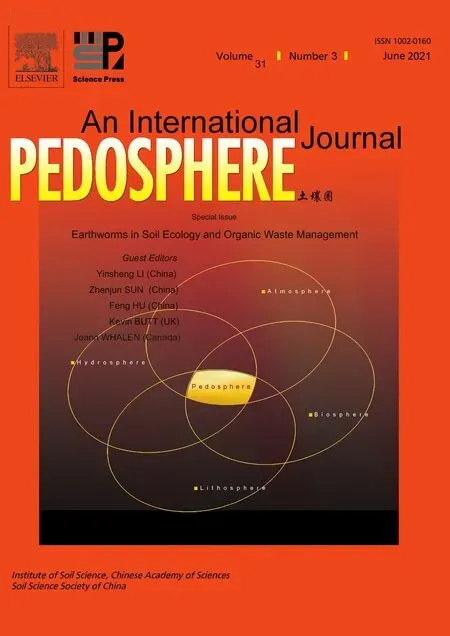Preface Earthworms in soil ecology and organic waste management
2021-11-27
Earthworms are important members of the soil macrofauna.Since C.Darwin(1881)described the important function of earthworms in pedogenesis and in maintenance of soil fertility,there has been continual interest in studying earthworm biology and ecology.Most of the attention in such studies is on earthworm functions in soil nutrient recycling.However,with increasing concerns about the environment,studies using earthworms to mediate organic waste treatment and as an indicator of soil pollution and remediation strategies have grown rapidly in recent years.It is under these circumstances that the 1st International Earthworm Congress(IEC1)was held on June 24—29,2018 in Shanghai,China.This congress joined the 11th International Symposium on Earthworm Ecology(ISEE 11),the 8th International Oligochaeta Taxonomy Meeting(IOTM 8),and the 1st International Earthworm Industry Forum(IEIF 1).It was the first joint meeting of these organizations,and thus many aspects of earthworm research were presented.This special issue includes 12 independent peer-reviewed papers selected as examples of the IEC1 achievements and results,mainly concerned with the relationships of earthworms in soil ecology and organic waste management.
Earthworm populations or communities in different soils or at different sites may influence soil ecology and the soil physico-chemical environment.Five papers in this special issue are concerned with this topic.Hoeffneret al.investigated the way the assembly of earthworm communities is driven by soil properties,grassland management,landscape diversity,and the presence of hedgerows in temperate grasslands of Brittany,France,and they concluded that earthworm ecological groups were responsive to specific environmental filters.Butt and Quigg studied earthworm community development at a former steelworks site,reclaimed using a mixture of colliery spoil and sewage sludge,and found that within 22 years,a species-rich community of earthworms colonized this site,with endogeicAporrectodea caliginosabeing dominant in number and anecicAporrectodea longabeing dominant in mass.Buttet al.investigated the ecology and behavior ofLumbricus badensis,one of the largest earthworm species in Europe,and obtained useful preliminary results for development of further studies.The deep burrowing speciesOctodrilus transpadanusand the litter-dwelling speciesDendrobaena octaedramay have been replaced by the invasiveLumbricus terrestrisin a beech woodland of the Bieszczady National Park,Poland since the 1980s(Mazur-Pa¸czkaet al.).The populations of three species,Aporrectodea turgida,Aporrectodea tuberculata,andLumbricus rubellus,are stable in temperate agricultural soils from a dairy farm(Quebec,Canada)receiving woodbased biochar(Whalenet al.).These papers added very valuable data about earthworm populations and communities in specific soil environments.
Soil nutrient transformations are mediated by microorganisms,but soil animals including earthworms play an important auxiliary role.Abail and Whalen estimated the direct nitrogen(N)flux from theAporrectodeapopulation in no-till corn-soybean agroecosystems during the corn and soybean rotations and quantitatively confirmed the Ntransformation rate from earthworms.Earthworms are abundant soil fauna in riparian buffers,with endogeic and epigeic species shown by Chenet al.to contribute to denitrifier activity in riparian soils.Earthworm casts can release CO2and N2O in soil,and the released amounts inAmynthasearthworm casts are significantly impacted by different wetting-drying cycles(Law and Lai).The N supply is especially important for environmentally sustainable and economically profitable crop production,and these studies showed that earthworms are deeply involved in this process.
Vermicomposting is an efficient and environmentfriendly method to treat organic wastes,and its product is the so-called“king of organic fertilizer”.Zhouet al.evaluated the decomposition product of six organic wastes—cattle dung,rice straw,garden waste,herbal waste,soybean straw,and tea residue—transformed byEisenia fetidaand found that only the former three were suitable as vermicompost without further manipulation.They also found that the N concentration negatively affected earthworm biomass and population status.Jafariet al.reported that phlogopite was partially weathered to vermiculite and interstratified micavermiculite during the vermicomposting process usingE.fetida.These findings help to better understand the function of earthworms during vermicomposting.
Heavy metal pollution of soils has become increasingly severe in recent years.Earthworm ecotoxicological research has sought to partially deal with the problem through biomonitoring and remediation of heavy metal pollution in soil.In this special issue,Wanget al.and Ninget al.studied the physiological responses ofE.fetidato arsenic and cadmium compounds,respectively.They found that changes in earthworm behavior and respiration,in addition to an oxidative stress model,hold promise as biomarkers of heavy metal pollution in soil.
The Guest Editors would like to express our sincere thanks,in particular to Prof.Ren Fang Shen,Editor-in-Chief ofPedosphere,Ms.Fenxiang Meng,Dean of Editorial Office ofPedosphere,and other colleagues for their financial support for IEC1 and the organization of this special issue.We also thank the anonymous reviewers for their useful and timely comments on the papers submitted to this issue.
杂志排行
Pedosphere的其它文章
- Letter to the Editor Field and laboratory investigations of Lumbricus badensis ecology and behaviour
- Strategies to mitigate the adverse effect of drought stress on crop plants—influences of soil bacteria:A review
- Advances in fungal-assisted phytoremediation of heavy metals:A review
- Study of oxidative stress cadmium(Cd)-induced in Eisenia fetida based on mathematical modeling
- Behavior and respiration responses of the earthworm Eisenia fetida to soil arsenite pollution
- Biological weathering of phlogopite during enriched vermicomposting
